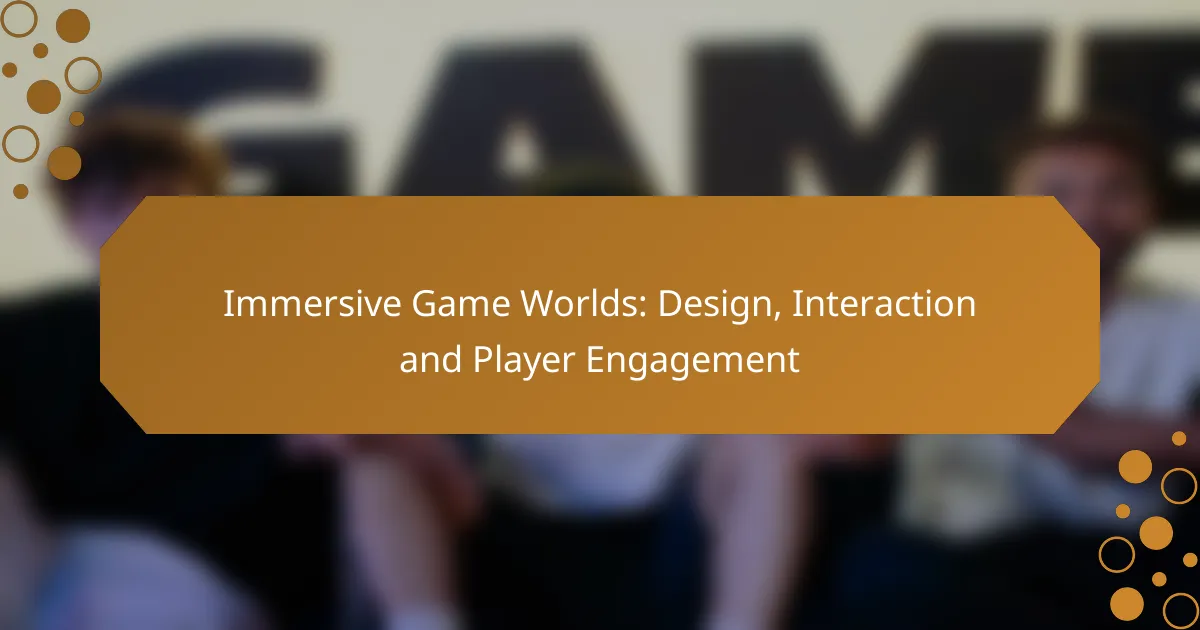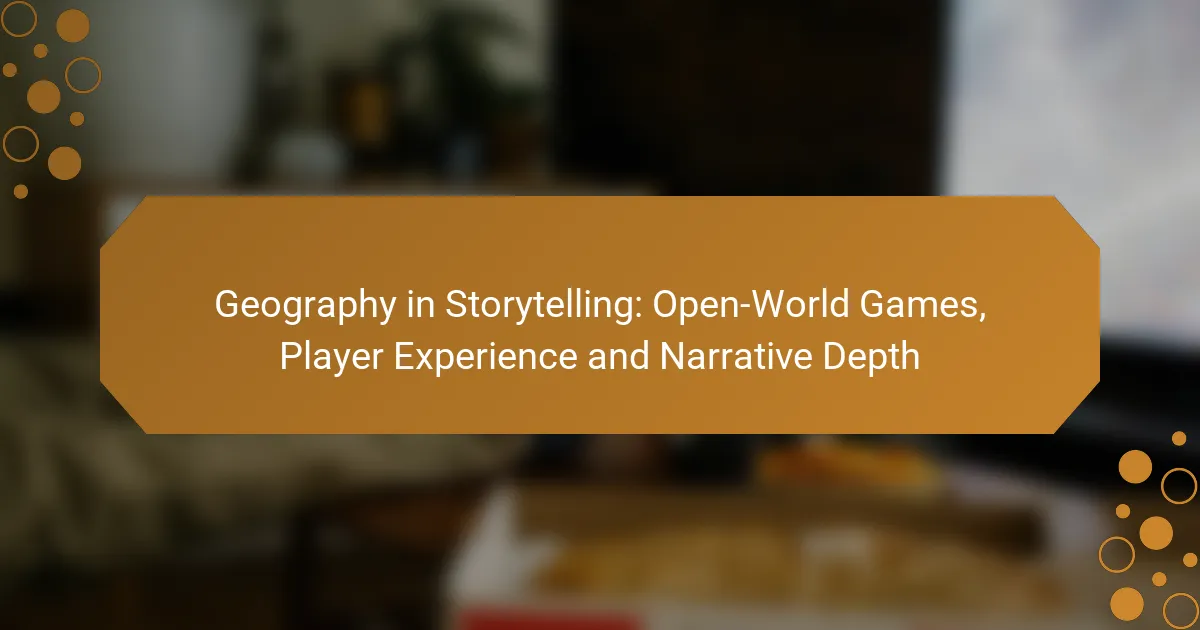World building is a crucial aspect of indie game development, allowing creators to craft immersive experiences even within tight budget constraints. By employing effective budget strategies and leveraging creative solutions, developers can design compelling characters, settings, and narratives that captivate players. Utilizing cost-effective tools and agile methodologies, indie developers can maximize their resources while maintaining high quality in their projects.
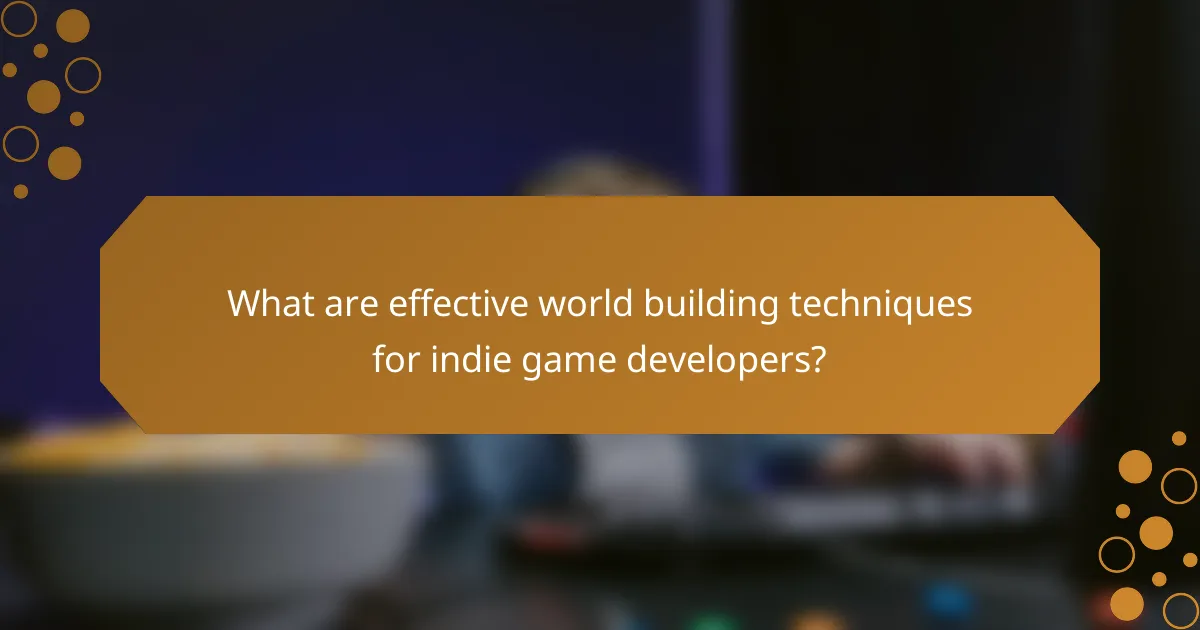
What are effective world building techniques for indie game developers?
Effective world building techniques for indie game developers focus on creating immersive experiences within budget constraints. By leveraging creativity and resourcefulness, developers can craft engaging characters, settings, and narratives that resonate with players.
Character development strategies
Character development is crucial for engaging players. Start by defining each character’s backstory, motivations, and relationships, ensuring they serve the game’s narrative. Use archetypes as a foundation, but add unique traits to differentiate them.
Consider creating a character sheet that outlines key attributes, skills, and emotional arcs. This can help maintain consistency and depth throughout the game. Regularly revisit and refine characters based on player feedback to enhance relatability.
Setting creation methods
Creating a compelling setting involves establishing a believable world that complements the narrative. Begin by outlining the world’s history, geography, and culture, ensuring they align with the characters’ journeys. Use mood boards or concept art to visualize the environment.
Utilize modular design techniques to build environments efficiently. This allows for reusing assets in different contexts, saving time and resources. Consider the emotional tone of each area and how it influences gameplay and player experience.
Storyline integration approaches
Integrating storyline elements seamlessly into gameplay enhances immersion. Start by mapping out the main plot points and how they connect to character arcs and settings. Use branching narratives to allow player choices to impact the story, fostering engagement.
Incorporate environmental storytelling through visual cues and background elements that reveal lore. This can be achieved with minimal dialogue, allowing players to discover the narrative organically as they explore the world.
Visual design principles
Visual design should reflect the game’s tone and enhance storytelling. Establish a consistent art style that aligns with the narrative and character designs. Use color palettes and lighting to evoke specific emotions and guide player focus.
Consider accessibility in visual design, ensuring that color choices and contrasts are suitable for all players. Regularly test visuals with a diverse audience to gather feedback and make necessary adjustments.
Community feedback utilization
Utilizing community feedback is vital for refining world building elements. Engage with players through forums, social media, or beta testing to gather insights on character, setting, and story effectiveness. Encourage constructive criticism to identify areas for improvement.
Implement a structured feedback process, such as surveys or focus groups, to gather specific information. Prioritize changes based on common themes in feedback while maintaining your creative vision. This iterative approach can significantly enhance the overall quality of the game.

How can budget strategies enhance world building?
Budget strategies can significantly enhance world building by allowing developers to allocate resources efficiently, maximizing creativity while minimizing costs. By leveraging cost-effective tools and open-source resources, indie developers can create immersive environments without overspending.
Cost-effective tools for design
Utilizing cost-effective tools can streamline the design process and reduce expenses. Software like Blender for 3D modeling and GIMP for image editing are free alternatives to expensive programs, enabling developers to create high-quality assets without a hefty price tag.
Consider using game engines like Unity or Unreal Engine, which offer free versions with robust features. These platforms provide templates and assets that can help speed up development while keeping costs low.
Open-source resources for indie developers
Open-source resources are invaluable for indie developers looking to enhance their world building without financial strain. Websites like OpenGameArt and FreeSound provide free assets, including graphics and sound effects, that can be integrated into projects.
Additionally, communities around open-source software often share tutorials and documentation, helping developers learn and implement new techniques effectively. Engaging with these communities can lead to collaborative opportunities and shared resources.
Funding options for indie projects
Securing funding is crucial for indie projects, and several options are available to support world building efforts. Crowdfunding platforms like Kickstarter and Indiegogo allow developers to present their ideas and gather financial backing directly from potential players.
Grants from organizations focused on the arts and technology can also provide financial support. Research local and international grants that cater to indie game development, as they can offer significant funding without the need for repayment.
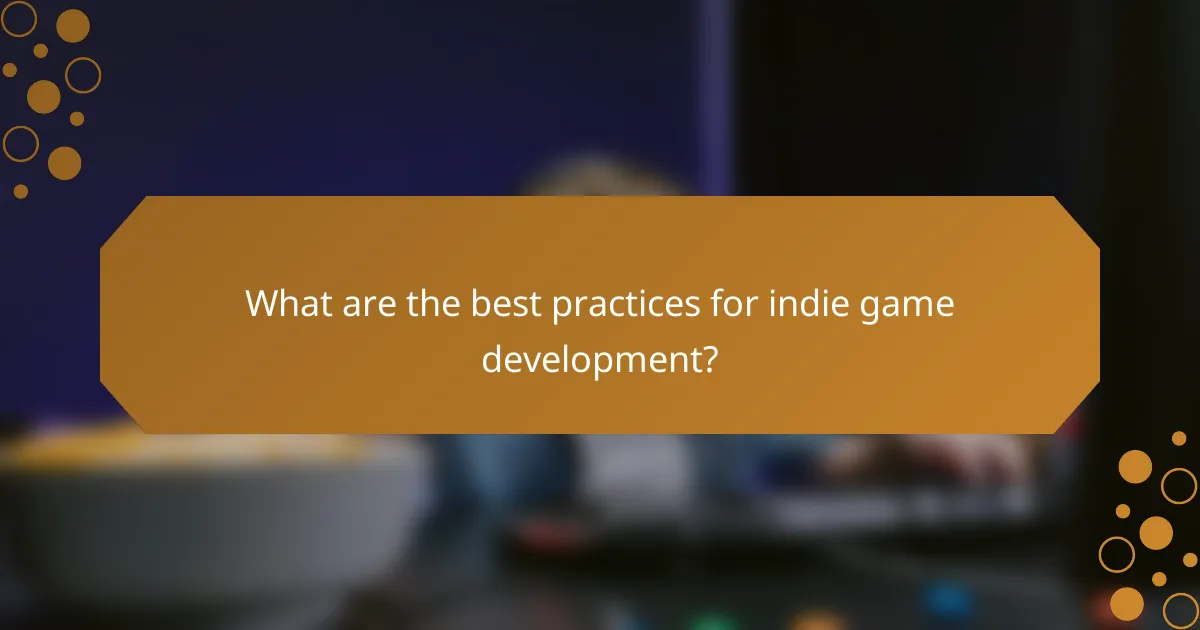
What are the best practices for indie game development?
Indie game development thrives on creativity and resourcefulness. Best practices include leveraging agile methodologies, effective prototyping techniques, and iterative testing processes to maximize efficiency and quality while minimizing costs.
Agile development methodologies
Agile development methodologies focus on flexibility and collaboration, allowing indie developers to adapt quickly to changes. This approach emphasizes short development cycles, known as sprints, which typically last from one to four weeks. By regularly reviewing progress and incorporating feedback, teams can ensure that the game evolves in line with player expectations.
Key frameworks like Scrum and Kanban can be particularly useful. Scrum involves defined roles and ceremonies, while Kanban emphasizes visualizing work in progress. Both methods help maintain focus and streamline communication among team members.
Prototyping techniques
Prototyping is essential for indie developers to test ideas and mechanics before full-scale production. Techniques can range from paper prototypes to digital mockups, depending on the complexity of the game. Rapid prototyping allows teams to iterate quickly, often using tools like Unity or Unreal Engine to create basic versions of gameplay.
Consider using a Minimum Viable Product (MVP) approach, which focuses on developing just enough features to satisfy early users. This strategy helps gather valuable feedback while conserving resources, ensuring that the final product aligns with player needs.
Iterative testing processes
Iterative testing processes are crucial for refining gameplay and identifying issues early. Regular playtesting sessions should be scheduled throughout development, allowing for continuous feedback from players. This can be done through closed alpha or beta tests, where selected users provide insights on gameplay mechanics and user experience.
Utilize tools for tracking bugs and player feedback, such as Trello or JIRA, to organize findings and prioritize fixes. Aim for a balance between addressing player concerns and maintaining the original vision of the game, ensuring that changes enhance rather than detract from the overall experience.

How can collaboration improve world building?
Collaboration can significantly enhance world building by bringing diverse perspectives and skills into the creative process. By working with others, creators can generate richer narratives, more detailed environments, and innovative ideas that might not emerge in isolation.
Working with freelance artists
Engaging freelance artists can elevate the visual aspects of your world, making it more immersive and appealing. When selecting artists, consider their style and how it aligns with your vision; platforms like Behance or ArtStation can help you find suitable candidates.
Establish clear communication and expectations from the start, including deadlines and budget constraints. A typical freelance rate can vary widely, often ranging from $20 to $100 per hour, depending on the artist’s experience and the complexity of the work.
Engaging with writing communities
Joining writing communities can provide valuable feedback and support for your world-building efforts. Online forums, social media groups, and local writing clubs offer opportunities to share ideas, receive critiques, and collaborate on projects.
Participate actively by sharing your work and engaging with others’ projects. This exchange can lead to partnerships or co-writing opportunities, enhancing the depth and breadth of your world. Be open to constructive criticism, as it can help refine your narrative and setting significantly.
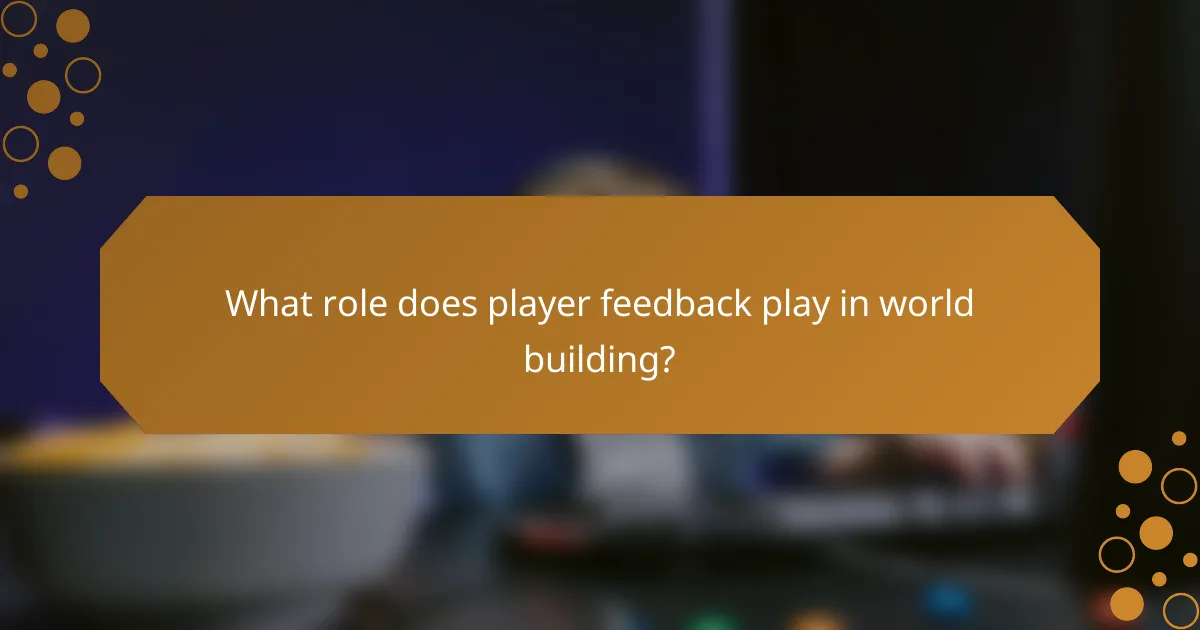
What role does player feedback play in world building?
Player feedback is crucial in world building as it helps developers understand what resonates with their audience. By actively listening to players, creators can refine their game environments, narratives, and mechanics to enhance engagement and satisfaction.
Incorporating player suggestions
Incorporating player suggestions involves gathering input through surveys, forums, and playtests. This feedback can highlight areas of the game that need improvement or elements that players particularly enjoy. For instance, if players express a desire for more diverse environments, developers can prioritize creating varied landscapes to meet these expectations.
To effectively integrate suggestions, developers should categorize feedback into actionable items. This can include creating a list of top-requested features or changes and assessing their feasibility within the project’s budget and timeline. Regularly updating players on how their feedback is being used fosters a sense of community and investment in the game’s development.
Testing narrative elements
Testing narrative elements is essential to ensure that the story and world-building resonate with players. This can be done through beta testing phases where players experience the game and provide insights on the plot, character development, and overall immersion. Observing player reactions during these tests can reveal which aspects of the narrative are compelling or confusing.
Developers should focus on key narrative components, such as dialogue, character arcs, and world lore, and solicit specific feedback on these elements. For example, asking players if they found a character relatable or if the world felt cohesive can guide revisions. Utilizing tools like A/B testing for different story paths can also help determine which narratives engage players more effectively.
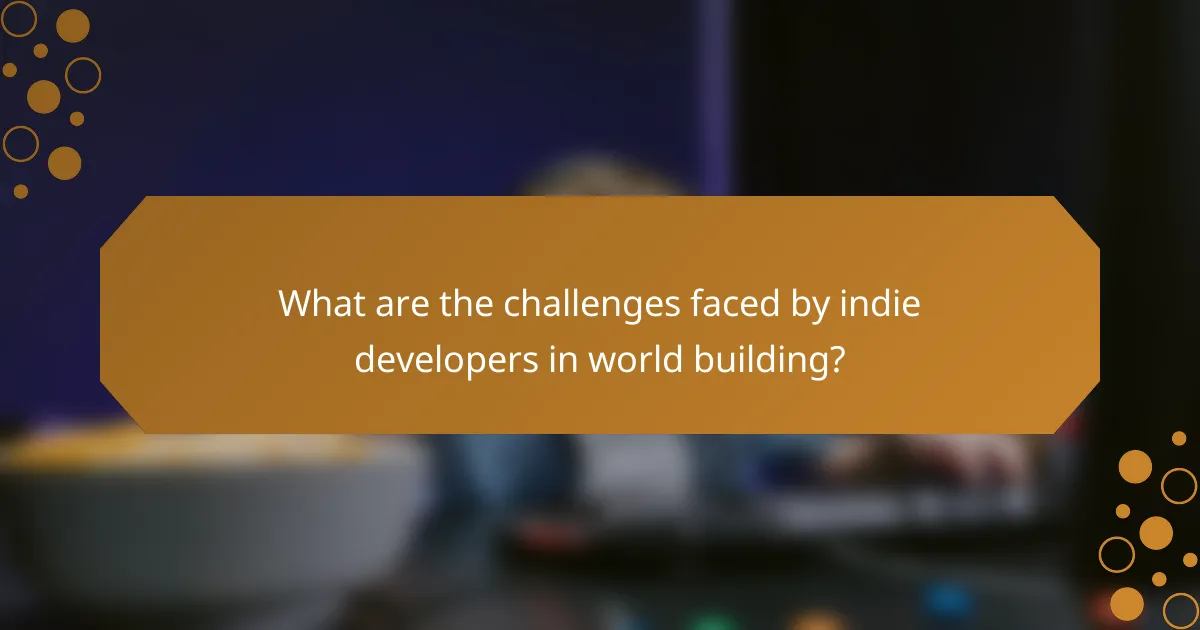
What are the challenges faced by indie developers in world building?
Indie developers often encounter various challenges in world building, primarily due to limited resources and budget constraints. These obstacles can hinder creativity and the overall development process, making it crucial to find effective strategies to overcome them.
Resource limitations
Resource limitations are a significant challenge for indie developers, affecting everything from finances to manpower. Many indie projects operate on tight budgets, often ranging from a few thousand to tens of thousands of dollars, which can restrict the scope of the world being built.
To manage these limitations, developers should prioritize essential elements of their world, focusing on key features that enhance gameplay and narrative. For instance, instead of creating a vast open world, consider designing a smaller, more detailed environment that can be richly populated with lore and interactive elements.
Additionally, leveraging free or low-cost tools and assets can help stretch budgets further. Platforms like Unity or Unreal Engine offer free versions, while marketplaces like itch.io provide affordable assets. Collaborating with other indie developers can also share resources and knowledge, fostering a supportive community.

